Reviews
Meres tou ‘36
Theodoros Angelopoulos
Greece, 1972
Credits
Review by Ian Johnston
Posted on 07 November 2012
Source Artificial Eye DVD
Categories Taking Time: The Cinema of Theodoros Angelopoulos
I deny that I have been influenced by Jancsó! Plan sequence [sic: i.e. plan-séquence, French for “sequence shot”] has existed throughout cinema history - in Murnau’s films, for example… I draw techniques from everything I’ve seen… I continue to love - and I am speaking from memory, since it is quite some time since I have seen them - very much the films of Murnau, Mizoguchi, Antonioni. More recently: Tarkovskij’s Stalker, Godard’s Every Man for Himself. And, of course, Ordet. But the only specific influences I acknowledge are Orson Welles, for his use of plan-sequence and deep focus, and Mizoguchi, for his use of time and off-camera space.1
But consider the evidence of Days of ‘36, Angelopoulos’ second film and his first in colour, as, in one scene, military on horseback wheel across a wide open plain, chasing down a handful of escaped prisoners, the final stage in a brief narrative of violence and oppression, rebellion, and the defeat of the weak at the hands of military might. The similarities to key Jancsó films of the mid-sixties, like The Round-Up and The Red and the White, are more than apparent. Now, it is true that, when considering his later, more mature style, Angelopoulos is on firmer ground when he declares that “Jancsó is someone I like indeed, but his use of the sequence shot is different from mine”.2 But the case of Days of ‘36 is something different. Angelopoulos hasn’t, so to speak, fully “digested” his influences, made them his own. There’s a sense in the film that he’s working through the possibilities of his filmmaking, embarking on a direction different from that of his debut Reconstruction. Here lies the fascination of the film, the sense that it gives us of a great director in the process of discovering himself, of creating his own unique aesthetic. The weakness of the film, however, is that this aesthetic is not yet fully developed.
Like all his films through to Megalexandros/Alexander the Great, Days of ‘36 takes as its subject matter an incident in Greek twentieth-century history, albeit here fictionalised to provide closer interconnections between the differing narrative strands.3 A speaker at a political rally is assassinated and Sofianos, a police informer, is arrested and imprisoned. Sofianos is visited in his prison cell by Kriezis, a Conservative member of parliament, whom he then holds hostage with a smuggled gun. We are then taken through the toing and froing of the authorities as they desperately try to devise a solution, all complicated by political machinations behind the scenes as the case begins to threaten the survival of the weak government. In the end the state resorts to another assassination, which brings the narrative around full circle.
Although the significance of 1936 to modern Greek history will be lost on most viewers, Angelopoulos makes the political tone of the day abundantly clear—all this in spite of his oblique and elliptical narrative and the amount of factual information he simply withholds from us. These Days of ‘36 are a time of increasing political polarisation, where the left is being forced out of the political process and a climate of fear is being instituted through an increasing military presence. Still, what was “1936”? It was a time of political paralysis in parliament after inconclusive elections (there are various references to this throughout the film), a situation that the King intervened in with his appointment of Ioannis Metaxas, a General and leader of a monarchist party, as Prime Minister. When Kriezis’ mother visits the Conservative Party Club, a political leader there refers to Metaxas when he states that “the General’s manoeuvring frightens me. He’s up to something.” Here Angelopoulos is pointing to what is yet to come in 1936: the 4th of August “self-coup” when Metaxas, with the King’s support, declared a state of emergency, suspended parliament, and instituted an authoritarian regime which borrowed many of its features from Italian Fascism.
The parallels with Angelopoulos’ own time are so apparent that it seems amazing he got all this past the censors. 1972 was well into the rule of the Greek colonels (1967-1974), who, like Metaxas, had been supported by the King (Constantine II, this time, rather than George II, his uncle) and who overthrew the government, dissolved political parties and suspended civil rights. The censors, perhaps, were happy enough with the film’s focus on the ineptitude of the political class of 1936 (this would have fit in with the Colonels’ disdain for parliamentary democracy) and missed the more subtle indictment of the military fascism to come. But his aesthetic strategy probably helped as well—on his website4 Angelopoulos is quoted as saying that “the dictatorship is embodied in the formal structure of the film. Imposed silence was one of the conditions under which we worked. The film is… made in such a way that the spectator realizes that censorship is involved.”
So much of the “action” of the film is played off-camera (we never enter Sofianos’ cell until the very end, never learn how he got hold of the smuggled gun, never know how unwilling a hostage Kriezis is); we’re either not privy to significant conversations or we cannot even hear the dialogue; and there’s so much information that’s simply denied us, even at the level of a character’s name. The net effect is to obscure what’s taking place in front of us. We can never be sure that Sofianos was the killer of the politician. Indeed, the synopsis on Angelopoulos’ website offers details (the murder victim is a trade unionist; Sofianos and Kriezis have a homosexual relationship) that are impossible to pick up from the film itself. This elliptical narrative style, where things are kept at a distance from us and we are asked to work at interpreting the hints and nuances of a scene or snatch of dialogue, is reinforced by Angelopoulos’ film style, the high-angle long shots (not such a defining feature of his later mature style) and the languorous 360° tracks and pans where a character will pass in and out of our and the camera’s gaze.
For all Angelopoulos’ concern in his work with issues of politics and history, his cinema is not a realist one but one of symbolic/poetic gesture and pictorial/aesthetic effect. And what distinguishes Days of ‘36 from his other work, even from his very next film The Travelling Players, is that he has not yet completely evolved this distinctive style. In aesthetic terms, it’s a formative, explorative work, still tied to a realist mode, or, as Angelopoulos himself calls it, to “naturalism”: “The point, evidently, is to follow an almost naturalistic course in order to better underline the realism of each sequence.”5 By “realism” Angelopoulos appears to mean an underlying “truth” that goes beyond the pro-filmic (in his terms, “naturalistic”) event; and in the same exchange with interviewer Ulrich Gregor Angelopoulos states his conviction that through his elliptical style he goes beyond naturalism. Personally, I don’t think this actually happens with Days of ‘36. The narrative ellipsis does give an interesting tension, the sense of an intellectual puzzle to the film, but the narrative itself very much grounded in the realistic depiction of one set of actions following another, on occasion to slightly drab effect. We don’t have6 the theatricalisation of events that will become the guiding principle of Angelopoulos’ sequence shot style.
Angelopoulos is hardly famed for a comic touch - he is a very serious film artist - yet in Days of ‘36 the tone he sets for much of the characterisation, in particular for the scenes set in the prison, is a mocking, ironic one. His high-angle camera in so many of the interior scenes casts a sardonic eye on the ineptitudes of the officials and politicians. In a pre-credits sequence the solemn passing of bed linen from prison warden to guards becomes a parody of bureaucratic niceties. This drily comic undermining is a consistent tone to the prison scenes as Angelopoulos portrays these men of power impotently circling the warden’s office, at a loss as to what to do; rushing en masse down corridors; huddling out of sight of Sofianos’ cell door; or wandering aimlessly over the empty wind-swept prison yard.
Even broader satire is aimed at the English ambassador who’s wandering a beach with his upper class friends, waiter on hand. Firing off a gun towards the sea, he declares “In general, I’m against violent solutions”—the precise implication, with Spain being invoked, is that he, in Angelopoulos’ eyes the personification of Britain, is very much for Metaxas’ imminent recourse to military repression. This figure is in a line of rather unsubtle caricatures of the English (think the soldiers in The Travelling Players or the aristocrats in Alexander the Great), a reflection of Angelopoulos’ own distaste for Britain’s historical record of meddling in Greece, above all regarding its role in the Civil War against the Left.
The Greek political class is similarly satirised in a threadbare ceremony that is held out in the countryside. Yoking together religion and classical culture in support of the government (the Metaxas regime declared itself the Third Hellenic Civilisation after ancient Greece and the Byzantine Empire) the emptiness of the whole ceremony is emphasised with the government representative’s pathetic drive-past over a barren wasteland.
But for all this comic-satiric tone - which is never, to be sure, laugh-out-loud - Angelopoulos’ focus is on the darkening political landscape of the historical setting (1936), which sets the stage for the repression he will detail in The Travelling Players and The Hunters, and which has clear parallels with his own day (1972). Underlining this is the way he brackets the fate of Sofianos with two double 360° pans. The first details the arrest of Sofianos (although we hear his name, we don’t yet know who he is) in a forest, where Sofianos’ own dread and panic are balanced by our own uncertainty in interpreting what is happening as Sofianos, his companion, and his pursuers slip in and out of the frame created by the ever-circling camera.
The second is the film’s stylistic tour de force. After a comic attempt at poisoning Sofianos - the ineptness of which is mocked when in the next scene the prosecutor strangles his laughter into his handkerchief at the officials’ role-playing - the authorities bring in a sharpshooter to dispose of him. This pan takes in Sofianos’ lighted window, the prison yard, and the roof on which a guard is setting up the rifle; the fatal shot is heard - never seen - when the camera finally arrives at the window on its second circuit, this time to zoom in on the hole made by the bullet. So, we never see the assassin at work (for all we know, he may have been responsible for the film’s first killing), for the individual actors, this man or woman rather than that one, are in a sense not relevant to Angelopoulos’ purpose, which is to analyse an entire society and political culture. And the anonymity of the film’s coda - three men executed in a field by the military, the corpses loaded on a cart, the camera craning up as cart and soldiers approach and (shades of Jancsó again!) a bugle sounds in the distance - makes it all the more chilling.
- Michael Wilmington, “Theo Angelopoulos: Landscapes, Players, Mist” in: Andrew Horton (ed.) The Last Modernist: The Films of Theo Angelopoulos, Westport, CT: Praeger, 1997, p. 63. ↩
- Dan Fainaru, “… And about All The Rest” in: Dan Fainaru (ed.) Theo Angelopoulos: Interviews, Jackson, MS: University Press of Mississippi, 2001, p. 131. ↩
- For example, the opening assassination and the prison incident were, historically, entirely separate events. Ulrich Gregor, “Unveiling the Patterns of Power: The Days of ‘36” in: Fainaru p. 10. ↩
- theoangelopoulos.com/daysof36.htm ↩
- Fainaru p. 12. ↩
- The scene on the beach with the British ambassador is the one major exception here, where there occurs the complex choreography of figures (ultimately, lined up across the frame) and shifting foci that we find in Angelopoulos’ subsequent films. ↩
More Taking Time: The Cinema of Theodoros Angelopoulos
-
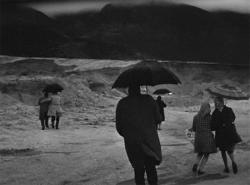
Reconstruction
1970 -
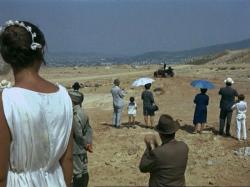
Days of ‘36
1972 -
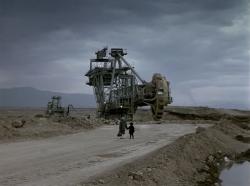
Landscape in the Mist
1988 -
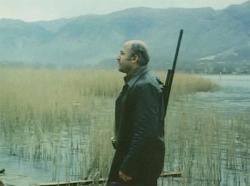
The Hunters
1977 -
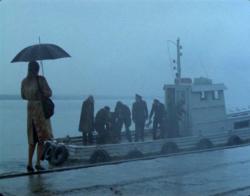
Voyage to Cythera
1983
We don’t do comments anymore, but you may contact us here or find us on Twitter or Facebook.



